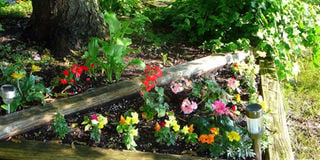Prime
Be your own landscaper

While some homeowners prefer planning their compounds or yards after construction, others prefer to plan it from the onset and begin planting trees, flowers and designing different aspects.
But whatever decision one takes, designing one’s own compound can save them the expenses of hiring a landscaper or compound designer.
Gardening, although complex requires a lot of dedication and creativity.
This, according to landscapers and compound designers will require one to look for a number of different plants while bearing in mind the aspect of colour and texture.
“While planting different flowers, ensure that particular flowers or plant varieties of your choice, with the same colours, and shapes are repeated or reused,” says Pius Oketcho, a landscape designer at Williams Compound designers.
Consider the size
When reviewing gardening ideas, Oketcho recommends that home owners put the aspect of space in mind. This, he says, determines what plants you require and how each idea will be incorporated in your yard.
Bigger compounds or yards, according to Sylivia Tulina, the director for Green Life designers, will allow homeowners experiment with a great number of landscaping ideas. A smaller space on the contrary will require one to use specific ideas that will fit in the space, without creating a shabby scene.
“A smaller yard will require you to plant double duty plants or plants that perform more than one function. Trees are recommended as they act as windbreakers, provide shade and at the same time provide a beautiful backdrop. According to Tulina, trees and shrubs often require the least amount of attention.
Incorporate containers
Containers add flexibility to the landscape. Although a number of homeowners prefer them on their porch, balcony or at the entrance, it is worth trying mixing them in flower beds or using them to create borders. This idea, according to Charles Makhokha, a gardener, works for big and small yards or compounds.
Integrate shades of green
Using a variety of shades of green such as dark green, richer tones and soft greens adds depth to one’s compound. RonaldoAtuhereza, a leader and marketer at Go Green Uganda says: “You can easily add a level of interest to your yard by incorporating an assortment of materials such as cut flagstones, smooth beach pebbles and gravel. Consult on what planting to grow together, colour combinations, shapes and what available materials to incorporate,” he recommends.
Play with shapes
Home designers recommend taking advantage of lines, shapes, and angles when reviewing your gardening ideas and laying out your yard to create impact.
Oketcho says: “Embrace plant shapes, and use them in your landscape ideas. For instance, tuck in a few tall, upright plants to draw the eye up and break up the monotony that comes along with using a lot of mounding shrubs and perennials.”
Atuhereza also notes: “Add interest to your yard with structure.” An example is using low fences or hedges. “Do this by dissecting your compound into spaces, and giving each space or room its own unique and attractive identity. Try out different ideas to suit your taste.”




